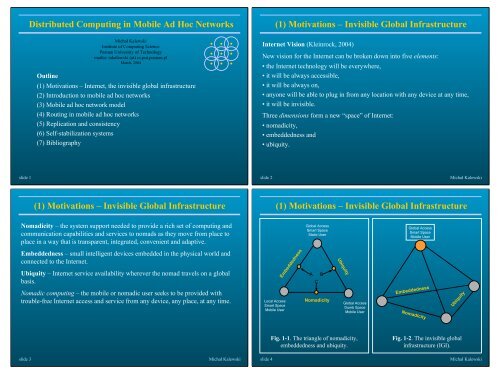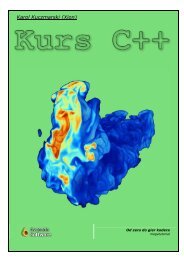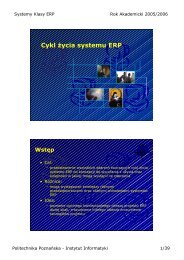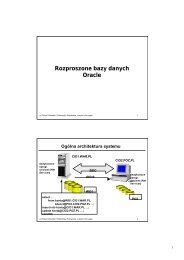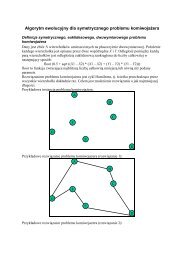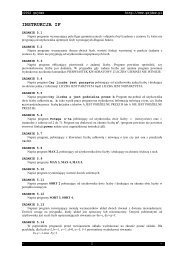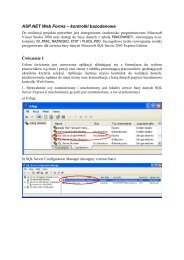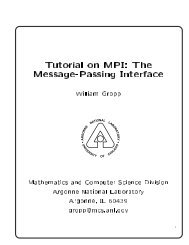Distributed Computing in Mobile Ad Hoc Networks (1) Motivations ...
Distributed Computing in Mobile Ad Hoc Networks (1) Motivations ...
Distributed Computing in Mobile Ad Hoc Networks (1) Motivations ...
You also want an ePaper? Increase the reach of your titles
YUMPU automatically turns print PDFs into web optimized ePapers that Google loves.
<strong>Distributed</strong> <strong>Comput<strong>in</strong>g</strong> <strong>in</strong> <strong>Mobile</strong> <strong>Ad</strong> <strong>Hoc</strong> <strong>Networks</strong>(1) <strong>Motivations</strong> – Invisible Global InfrastructureOutl<strong>in</strong>eMichał KalewskiInstitute of <strong>Comput<strong>in</strong>g</strong> SciencePoznan University of Technologymailto: mkalewski (at) cs.put.poznan.plMarch, 2004(1) <strong>Motivations</strong> – Internet, the <strong>in</strong>visible global <strong>in</strong>frastructure(2) Introduction to mobile ad hoc networks(3) <strong>Mobile</strong> ad hoc network model(4) Rout<strong>in</strong>g <strong>in</strong> mobile ad hoc networks(5) Replication and consistency(6) Self-stabilization systems(7) BibliographyInternet Vision (Kle<strong>in</strong>rock, 2004)New vision for the Internet can be broken down <strong>in</strong>to five elements:• the Internet technology will be everywhere,• it will be always accessible,• it will be always on,• anyone will be able to plug <strong>in</strong> from any location with any device at any time,• it will be <strong>in</strong>visible.Three dimensions form a new “space” of Internet:• nomadicity,• embeddedness and• ubiquity.slide 1slide 2Michał Kalewski(1) <strong>Motivations</strong> – Invisible Global Infrastructure(1) <strong>Motivations</strong> – Invisible Global InfrastructureNomadicity – the system support needed to provide a rich set of comput<strong>in</strong>g andcommunication capabilities and services to nomads as they move from place toplace <strong>in</strong> a way that is transparent, <strong>in</strong>tegrated, convenient and adaptive.Global AccessSmart SpaceStatic UserGlobal AccessSmart Space<strong>Mobile</strong> UserEmbeddedness – small <strong>in</strong>telligent devices embedded <strong>in</strong> the physical world andconnected to the Internet.Ubiquity – Internet service availability wherever the nomad travels on a globalbasis.Nomadic comput<strong>in</strong>g – the mobile or nomadic user seeks to be provided withtrouble-free Internet access and service from any device, any place, at any time.Local AccessSmart Space<strong>Mobile</strong> UserEmbeddednessACBNomadicityUbiquityGlobal AccessDumb Space<strong>Mobile</strong> UserEmbeddednessNomadicityUbiquityFig. 1-1. The triangle of nomadicity,embeddedness and ubiquity.Fig. 1-2. The <strong>in</strong>visible global<strong>in</strong>frastructure (IGI).slide 3Michał Kalewskislide 4Michał Kalewski
(2) Introduction to <strong>Mobile</strong> <strong>Ad</strong> <strong>Hoc</strong> <strong>Networks</strong>(2) Introduction to <strong>Mobile</strong> <strong>Ad</strong> <strong>Hoc</strong> <strong>Networks</strong><strong>Mobile</strong> ad hoc networks (MANETs) are composed of autonomous mobilestations (hosts) communicat<strong>in</strong>g through wireless l<strong>in</strong>ks, without any fixedbackbone support – <strong>in</strong> a decentralized manner.<strong>Mobile</strong> hosts can thus exchange <strong>in</strong>formation <strong>in</strong> areas that do not have a preexist<strong>in</strong>g<strong>in</strong>frastructure.A message sent by host may be received by all the nodes (that is hosts) <strong>in</strong> itsvic<strong>in</strong>ity, i.e., by all of its neighbors.Hosts can come and go or appear <strong>in</strong> new places; so with an ad hocnetwork, thetopology may be chang<strong>in</strong>g all the time (without warn<strong>in</strong>gs) – such networks canget partitioned and reconnected.Each node <strong>in</strong> MANETs functions as both a comput<strong>in</strong>g host and a router; thecontrol of the network is distributes among the nodes.Among the possibilities of use mobile adhoc networks i.e. are (Tanenbaum, 2003):• military vehicles on battlefield,• a fleet of ships at sea,• emergency workers at an earthquakethat destroyed the <strong>in</strong>frastructure,• a gather<strong>in</strong>g of people with notebookcomputers <strong>in</strong> a area lack<strong>in</strong>g 802.11:(i) non-802.11 mode (Lucent),(ii) <strong>in</strong>dependent BSS 1 mode.1) Basic Service SetADFBRange of A’sbroadcastFig. 2-1. Example of MANET.GCEslide 5Michał Kalewskislide 6Michał Kalewski(2) Introduction to <strong>Mobile</strong> <strong>Ad</strong> <strong>Hoc</strong> <strong>Networks</strong>(2) Introduction to <strong>Mobile</strong> <strong>Ad</strong> <strong>Hoc</strong> <strong>Networks</strong>IEEE Wireless 802.11 StandardsWLANs can operate <strong>in</strong> one of two configurations: with a access po<strong>in</strong>t (AP) andwithout access po<strong>in</strong>t – ad hoc network.(a)To wirednetwork(b)IEEE Wireless 802.11 Standards802.11 standard specifies five transmission techniques allowed <strong>in</strong> physical layer:• <strong>in</strong>frared method – 1997,• Frequency Hopp<strong>in</strong>g Spread 2 Spectrum (FHSS) – 1997,• Direct Sequence Spread Spectrum (DSSS) – 1997,• Orthogonal Frequency Division Multiplex<strong>in</strong>g (OFDM) – 1999,• High Rate Direct Sequence Spread Spectrum (HR-DSSS) – 1999.In MAC sublayer (IEEE data l<strong>in</strong>k layer is subdivided <strong>in</strong>to MAC and LLCsublayers) 802.11 support two modes of operation: <strong>Distributed</strong> Coord<strong>in</strong>ationFunction (DCF) and Po<strong>in</strong>t Coord<strong>in</strong>ation Function (PCF).slide 7Fig. 2-2. (a) Wireless network with access po<strong>in</strong>t; (b) ad hoc network.Michał Kalewski2)The amount of <strong>in</strong>formation that electromagnetic wave can carry is related to its bandwidth:c∆λ∆f =2slide 8λMichał Kalewski
(2) Introduction to <strong>Mobile</strong> <strong>Ad</strong> <strong>Hoc</strong> <strong>Networks</strong>(2) Introduction to <strong>Mobile</strong> <strong>Ad</strong> <strong>Hoc</strong> <strong>Networks</strong>IEEE Wireless 802.11 StandardsWhen DCF is employed, 802.11 uses a protocol called Carrier Sense MultipleAccess / Collision Avoidance (CSMA/CA).Two methods of operation are supported by CSMA/CA: collision detection (withEthernet backoff algorithm) and collision avoidance.ABCDRTSCTSDATANAVNAVACKControlframePCFframesDCFframesBadframeCSMA/CA – with collision avoidance – is based on Multiple Access withCollision Avoidance for Wireless (MACAW) protocol (Fig. 2-3).In PCF the access po<strong>in</strong>t polls the other stations, ask<strong>in</strong>g them if they have anyframes to send.RTS – Request To SendCTS – Clear To SendNAV – Network Allocation VectorACKThe basic mechanism is for the access po<strong>in</strong>t to broadcast a beacon frameperiodically; it conta<strong>in</strong>s system parameters and it also <strong>in</strong>vites new stations to signup for poll<strong>in</strong>g service.PCF and DCF can coexist with<strong>in</strong> one network-cell (Fig. 2-4).Fig. 2-3. CSMA/CA: A wants tosend to B, C is a station with<strong>in</strong> rangeof A, D is a station with<strong>in</strong> range ofB but not with<strong>in</strong> range of A.Fig. 2-4. Interframe spac<strong>in</strong>g <strong>in</strong>802.11slide 9Michał Kalewskislide 10Michał Kalewski(2) Introduction to <strong>Mobile</strong> <strong>Ad</strong> <strong>Hoc</strong> <strong>Networks</strong>(3) <strong>Mobile</strong> <strong>Ad</strong> <strong>Hoc</strong> Network ModelStandard Frequency [GHz] Spread Data rate [Mbit/s]IEEE 802.11-DS 2,4 DSSS 1 / 2IEEE 802.11-FH 2,4 FHSS 1 / 2IEEE 802.11b 2,4 DSSS 1 / 2 / 5,5 / 11IEEE 802.11g 2,4 OFDMIEEE 802.11a 5 OFDMOther IEEE wireless standards:Tab. 2-1. IEEE 802.11 wireless standards.6 / 9 / 12 / 18 / 24 /36 / 48 / 546 / 9 / 12 / 18 / 24 /36 / 48 / 54• 802.16 – “Air Interface for Fixed Broadband Wireless Access Systems”,wireless MAN;• 802.15 – Bluetooth.slide 11Michał KalewskiThe topology of the ad hoc network is modeled by a undirected graph G = (V,E),where V is the set of nodes (hosts-routers) and E is the set of l<strong>in</strong>ks betweenneighbor<strong>in</strong>g nodes (that is between nodes that can communicate directly).S<strong>in</strong>ce the nodes are mobile, the E set changes with time.We assume that l<strong>in</strong>ks between two adjacent nodes are always bidirectional andevery node v∈V has a unique physical address or id.G C : the V set can change with time.G NC : the V set does not change with time.G P : graph G can get partitioned 3 and reconnected.G NP : graph G does not get disconnected (partitioned).G C|P , G C|NP , G NC|P , G NC|NP3)Partition<strong>in</strong>g fragments the graph <strong>in</strong>to isolated subgraphs called partitions (there is a path <strong>in</strong>E for any two nodes <strong>in</strong> the same partition but there is not a path <strong>in</strong> E for any two nodes <strong>in</strong>different partitions).slide 12Michał Kalewski
(4) Rout<strong>in</strong>g <strong>in</strong> <strong>Mobile</strong> <strong>Ad</strong> <strong>Hoc</strong> <strong>Networks</strong>“<strong>Ad</strong> hoc rout<strong>in</strong>g is a red-hot research area”, (Tanenbaum, 2003).Frequent topology changes caused by node mobility <strong>in</strong> MANETs make rout<strong>in</strong>g<strong>in</strong> ad hoc networks a challeng<strong>in</strong>g problem.Rout<strong>in</strong>g protocols can be classified <strong>in</strong>to three different groups (Abolhasan,Dutkiewicz and Wysocki, 2003):• global/proactive – the routes to all the dest<strong>in</strong>ations are determ<strong>in</strong>ed at the startup and ma<strong>in</strong>ta<strong>in</strong>ed by us<strong>in</strong>g periodic route update process;• on-demand/reactive – the routes are determ<strong>in</strong>ed when they are required by thesource us<strong>in</strong>g a route discovery process;• hybrid – comb<strong>in</strong>e the basic properties of the first two classes of protocols <strong>in</strong>toone.(4) Rout<strong>in</strong>g <strong>in</strong> <strong>Mobile</strong> <strong>Ad</strong> <strong>Hoc</strong> <strong>Networks</strong><strong>Ad</strong> <strong>Hoc</strong> On-Demand Distance Vector (AODV) (Perk<strong>in</strong>s and Royer, 1999)AODV is a reactive rout<strong>in</strong>g protocol, that is it determ<strong>in</strong>es a route to somedest<strong>in</strong>ation only when some host wants to send a packet to that dest<strong>in</strong>ation.The Algorithm.struct ROUTE_REQUEST {src_addr; //typically IP addressrequest_id; //<strong>in</strong>cremented whenever a ROUTE_REQUEST is broadcastdest_addr;dest_seq; //the most recent value of P j ’s sequence value that P i has seenhop_count //keep truck of how many hops the packet has made}struct ROUTE_REPLY {src_addr; dest_addr; // copied from <strong>in</strong>com<strong>in</strong>g ROUTE_REQUESTdest_seq; //taken from local counter <strong>in</strong> memoryhop_count;lifetime //controls how long the route is valid}slide 13Michał Kalewskislide 14Michał Kalewski(4) Rout<strong>in</strong>g <strong>in</strong> <strong>Mobile</strong> <strong>Ad</strong> <strong>Hoc</strong> <strong>Networks</strong><strong>Ad</strong> <strong>Hoc</strong> On-Demand Distance Vector Protocol• If P i does not have entry <strong>in</strong> rout<strong>in</strong>g table for P j , it has to discover a route toP j (this property makes this algorithm “on-demand”) by construct andbroadcast ROUTE_REQUEST packet.• When a ROUTE_REQUEST packet arrives at a node P k (k ≠ j), it isprocessed <strong>in</strong> the follow<strong>in</strong>g steps:(1) is looked up <strong>in</strong> a local history table: (i) if thisrequest has already been processed, it is discarded and process<strong>in</strong>g stops; (ii)if it is not a duplicate, the pair is entered <strong>in</strong>to the history table.(2) P k looks up the dest<strong>in</strong>ation <strong>in</strong> its route table: if dest_seq rt ≥ dest_seq aROUTE_REPLY packet is sent back to the source (dest_seq rt – sequencenumber stored <strong>in</strong> the local rout<strong>in</strong>g table); else step (3) is executed.(4) Rout<strong>in</strong>g <strong>in</strong> <strong>Mobile</strong> <strong>Ad</strong> <strong>Hoc</strong> <strong>Networks</strong><strong>Ad</strong> <strong>Hoc</strong> On-Demand Distance Vector Protocol(3) P k <strong>in</strong>crements the hop_count field and rebroadcasts the packet; data frompacket are stored as a new entry <strong>in</strong> local reverse route table (a timer is alsostarted for newly-made reverse route entry).• In response to the <strong>in</strong>com<strong>in</strong>g request, Pj builds a ROUTE_REPLY packet andunicast it to the node that the ROUTE_REQUEST packet came from.• At each node on the way back (ROUTE_REQUEST) reverse route table isused to unicasts the packet to the source; local host also updates 4) its rout<strong>in</strong>gtable if one (or more) of the follow<strong>in</strong>g three conditions are met: (i) no routeto P j is know, (ii) the sequence number for P j <strong>in</strong> the ROUTE_REPLY packet isgreater than the value <strong>in</strong> the rout<strong>in</strong>g table, (iii) the sequence numbers areequal but the new route is shorter.• Periodically, each node broadcast a Hello message for route ma<strong>in</strong>tenance.4)In this way, all the nodes on the reverse route learn the route to P j as a byproduct of P i discovery.slide 15Michał Kalewskislide 16Michał Kalewski
(4) Rout<strong>in</strong>g <strong>in</strong> <strong>Mobile</strong> <strong>Ad</strong> <strong>Hoc</strong> <strong>Networks</strong><strong>Ad</strong> <strong>Hoc</strong> On-Demand Distance Vector ProtocolBBBAAADCDCDEF EF EGGGFig. 4-1. Route discovery from A to G (arrows <strong>in</strong>dicate reverse routes).CF(4) Rout<strong>in</strong>g <strong>in</strong> <strong>Mobile</strong> <strong>Ad</strong> <strong>Hoc</strong> <strong>Networks</strong>Other rout<strong>in</strong>g protocols for ad hoc networks (Abolhasan, Dutkiewicz andWysocki, 2003):• proactive – Dest<strong>in</strong>ation-sequenced distance vector (DSDV), Wireless rout<strong>in</strong>gprotocol (WRP), Global state rout<strong>in</strong>g (GSR), Fisheye state rout<strong>in</strong>g (FSR),Source-tree adaptive rout<strong>in</strong>g (STAR), Distance rout<strong>in</strong>g algorithm for mobility(DREAM), Cluster-head gateway switch rout<strong>in</strong>g (CGSR);• reactive – AODV, Dynamic source rout<strong>in</strong>g (DSR), Rout<strong>in</strong>g on-demand acyclicmulti-path (ROAM), Light-weight mobile rout<strong>in</strong>g (LMR), Temporally orderedrout<strong>in</strong>g algorithm (TORA), Associativity-base rout<strong>in</strong>g (ABR), Signal stabilityadaptive (SSA), Cluster-based rout<strong>in</strong>g protocol (CBRP);• hybrid – Zone rout<strong>in</strong>g protocol (ZRP), Zone-based hierarchical l<strong>in</strong>k state(ZHLS), <strong>Distributed</strong> spann<strong>in</strong>g trees based rout<strong>in</strong>g protocol (DST), <strong>Distributed</strong>dynamic rout<strong>in</strong>g (DDR), Scalable location update rout<strong>in</strong>g protocol (SLURP).slide 17Michał Kalewskislide 18Michał Kalewski(5) Replication and ConsistencyIn ad hoc networks, s<strong>in</strong>ce mobile hosts move freely, disconnections occurfrequently and this causes frequent network division. Consequently, dataaccessibility <strong>in</strong> MANETs is lower than <strong>in</strong> fixed networks.One possible approach for this problem is to replicate <strong>in</strong>formation at multiplenodes; but the problem that comes with replication is the dangerof<strong>in</strong>consistency.(5) Replication and ConsistencyIn order to determ<strong>in</strong>e the optimal allocation of replicas, we must f<strong>in</strong>d a whichgives the highest data accessibility consider<strong>in</strong>g the follow<strong>in</strong>g parameters:(i) the access frequency from each mobile host to each data item;(ii) the probability that each node will participate <strong>in</strong> the network and willdisappear from the network;(iii) the probability that each two nodes connected by a l<strong>in</strong>k (neighbors) will bedisconnected and(iv) the probability that each two disconnected nodes will be connected.{Other methods of replica distribution assume that location of the node def<strong>in</strong>esthe access probability for each piece of data item (Ishihara, Mizuno, Tamori,Watanabe, 2002).}slide 19Michał Kalewskislide 20Michał Kalewski
(5) Replication and ConsistencyReplica Allocation Methods (Hara, 2001)• Static Access Frequency (SAF): each node allocates replicas of C data items <strong>in</strong>descend<strong>in</strong>g order of the access frequencies;• Dynamic Access Frequency and Neighborhood (DAFN): the access frequencyand to each data item and the neighborhood among nodes are taken <strong>in</strong>to account;• Dynamic Connectivity based Group<strong>in</strong>g (DCG): shares replicas <strong>in</strong> larger groupsof nodes than the DAFN method; <strong>in</strong> order to share replicas effectively, eachgroup should be stable, so the DCG creates groups that are biconnectedcomponents 5) .(5) Replication and ConsistencyConsistency <strong>in</strong> Partitioned <strong>Networks</strong> (Davidson, Garcia-Mol<strong>in</strong>a, 1985)When design<strong>in</strong>g a system that will operate when it is partitioned, the compet<strong>in</strong>ggoals of availability and correctness must somehow be met.Correctness can be archived simply by suspend<strong>in</strong>g operation <strong>in</strong> all but one of thepartition groups and forward<strong>in</strong>g updates at recovery (data must be correct whenrecovery is complete); but this severely compromises availability.Availability – the system’s normal function should be disrupted as little aspossible.5)Biconnected component denotes a maximum partial graph G which is connected (not divided) ifan arbitrary node <strong>in</strong> the graph G is deleted.slide 21Michał Kalewskislide 22Michał Kalewski(5) Replication and Consistency(5) Replication and ConsistencyConsistency <strong>in</strong> Partitioned <strong>Networks</strong>Classification of strategies:• pessimistic strategies prevent <strong>in</strong>consistencies by limit<strong>in</strong>g availability; optimisticstrategies do not limit availability;• syntactic approaches use on-copy serializability 6) as their sole correctnesscriterion; semantic approaches use the semantic of the transactions or thesemantics of data <strong>in</strong> def<strong>in</strong><strong>in</strong>g correctness.Consistency <strong>in</strong> Partitioned <strong>Networks</strong>OptimisticStrategiesPessimisticStrategiesSyntactic ApproachesVersion VectorsThe Optimistic ProtocolPrimary Site CopyTokensVot<strong>in</strong>gMiss<strong>in</strong>g WritesAccessible Copies AlgorithmClass Conflict AnalysisSemantic ApproachesLog TransformationsData-PatchGeneral Quorum Consensus6)On-copy serializability – the concurrent execution of operations on a replicated data is equivalentto a serial execution on non-replicated data.slide 23Michał Kalewskislide 24Tab. 5-1. Survey of solutions for consistency <strong>in</strong> partitioned networks.Michał Kalewski
(5) Replication and ConsistencyConsistent Update Diffusion <strong>in</strong> MANETs (Becker, Hähner, Rothermel, 2002)Earlier solutions that do consider network partition<strong>in</strong>g approach the problemfrom the direction of replica consistency <strong>in</strong> distributed systems and databases;while the problems are similar, several <strong>in</strong>stances of <strong>in</strong>formation dissem<strong>in</strong>ation <strong>in</strong>ad hoc networks are different.Strong consistency may result <strong>in</strong> MANETs <strong>in</strong> poor availability if the presence offrequent network partition<strong>in</strong>g; therefore, weaker consistency levels have beenproposed to <strong>in</strong>crease the availability.In most replica consistency solutions, on merger of partitions the replicas <strong>in</strong> themerg<strong>in</strong>g partitions are synchronized so that they have the same values. This<strong>in</strong>curs very high communication overheads which are not acceptable <strong>in</strong> wirelessad hoc networks.(5) Replication and ConsistencyConsistent Update Diffusion <strong>in</strong> MANETsLocal observation consistent (LOC)∀∀x xn ∈ Copies( x):(C1) x n will eventually converge to the most recently propagated state of x;kx j(C2) once x n has reached state , it will no longer accept state with l < k.{≈ pipel<strong>in</strong>ed RAM consistency}lx jslide 25Michał Kalewskislide 26Michał Kalewski(5) Replication and ConsistencyConsistent Update Diffusion <strong>in</strong> MANETsGlobal observation consistent (GOC)Copies(x) is local observation consistent (C1)(C2) and∀∀x xn ∈ Copies( x):kx i(C3) once x n has reached state , it will no longer accept state with .lx jx → xljki(5) Replication and ConsistencyConsistent Update Diffusion <strong>in</strong> MANETsw 1 (x)v 1 w 1 (x)v 2 w 1 (x)v 3P 1P 2w 2 (x)v 4 w 2 (x)v 5P 2 LOC serialization: w 1 (x)v 1 2 w 2 (x)v 4 2 w 1 (x)v 3 2 w 2 (x)v 5{≈ casual consistency}P 2 GOC serialization: w 1 (x)v 1 2 w 1 (x)v 3 2 w 2 (x)v 4 2 w 2 (x)v 5w 1 (x)v 2Fig. 5-1. Local and global observation consistency example.slide 27Michał Kalewskislide 28Michał Kalewski
(5) Replication and ConsistencyConsistent Update Diffusion <strong>in</strong> MANETsOrig<strong>in</strong>al LOC and GOC algorithms are based on flood<strong>in</strong>g 7) .Consistent update diffusion with LOC or GOC allows also for variety monitor<strong>in</strong>g,track<strong>in</strong>g and navigation us<strong>in</strong>g global <strong>in</strong>formation.7)Flood<strong>in</strong>g – a source s sends the message to all its neighbors; when a node other than dest<strong>in</strong>ation dreceives the message the first time it re-sends it to all its neighbors.slide 29Michał Kalewski(6) Self-stabilization Systems“We call the system ‘self-stabiliz<strong>in</strong>g’ if and only if, regardless of the privilegeselected each time for the the next move, at least one privilege will always bepresent and the system is guaranteed to f<strong>in</strong>d itself <strong>in</strong> a legitimate state after a f<strong>in</strong>itenumber of moves”, (Dijkstra, 1974).Self-stabilization is amenable to the layered approach, (Schneider, 1993).We could denote that if S is self-stabiliz<strong>in</strong>g with respect to P then TRUE P <strong>in</strong> S.The relation is transitive, if Q P and P R, then Q R.Informally we can see how transitivity corresponds to the technique of layer<strong>in</strong>g:given S 1 satisfy<strong>in</strong>g Q P and S 2 satisfy<strong>in</strong>g P R, we comb<strong>in</strong>e S 1 and S 2 such thatS 2 reads from the variables of S 1 to produce a new program satisfy<strong>in</strong>g Q R.Most <strong>in</strong>terest<strong>in</strong>g self-stabiliz<strong>in</strong>g algorithms for MANETs: mutual exclusion,spann<strong>in</strong>g tree construction and other graph theory problems.slide 30Michał KalewskiBibliographyBibliographyABOLHASAN M., DUTKIEWICZ E., WYSOCKI T.: A review of rout<strong>in</strong>g protocols for mobilead hoc networks, <strong>Ad</strong> <strong>Hoc</strong> <strong>Networks</strong>, Elsevier, 2003.BECKER Ch., HÄHNER J., ROTHERMEL K.: Consistent update diffusion <strong>in</strong> mobile ad hocnetworks, University of Stuttgart Technical Report, 2002.DAVIDSON S.B., GARCIA-MOLINA H.: Consistency <strong>in</strong> Partitioned <strong>Networks</strong>, <strong>Comput<strong>in</strong>g</strong>Surveys, Vol. 17, No. 3, 1985.DIJKSTRA E.:HARA T.:Self -stabiliz<strong>in</strong>g systems <strong>in</strong> spite of distributed control, Commun. ACM 17, pp.643-644, 1974.Effective replica allocation <strong>in</strong> ad hoc networks for improv<strong>in</strong>g dataaccessibility, IEEE INFOCOM, 2001.ISHIHARA S., MIZUNO T., TAMORI M., WATANABE T.: A replica distribution method withconsideration of the positions of mobile hosts on wireless ad-hoc networks,Proceed<strong>in</strong>gs of the 22nd International Conference on <strong>Distributed</strong> <strong>Comput<strong>in</strong>g</strong>Systems Workshops, 2002.KLEINROCK L.:. . .An Internet vision: the <strong>in</strong>visible global <strong>in</strong>frastructure, <strong>Ad</strong> <strong>Hoc</strong> <strong>Networks</strong>,Elsevier, 2004.PERKINS C.E., ROYER E.: <strong>Ad</strong> <strong>Hoc</strong> On-Demand Distance Vector Rout<strong>in</strong>g, Proc. Second Ann.IEEE Workshop on <strong>Mobile</strong> <strong>Comput<strong>in</strong>g</strong> Systems and Applications, IEEE,pp.90-100, 1999.SCHNEIDER M.: Self-stabilization, ACM <strong>Comput<strong>in</strong>g</strong> Surveys, 1993.TANENBAUM A.S.:Computer <strong>Networks</strong>, New Jersey, Prentice Hall PTR, 2003.slide 31Michał Kalewskislide 32Michał Kalewski


